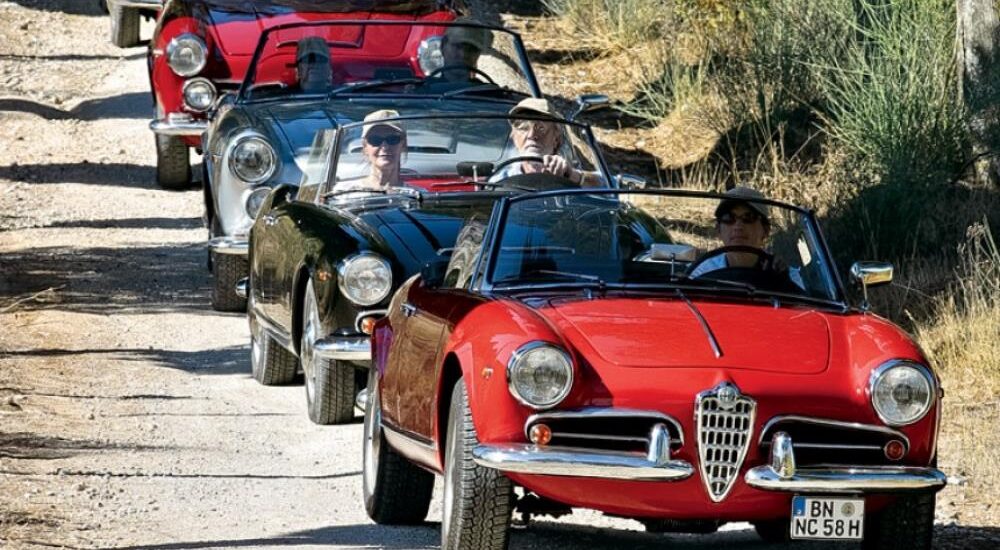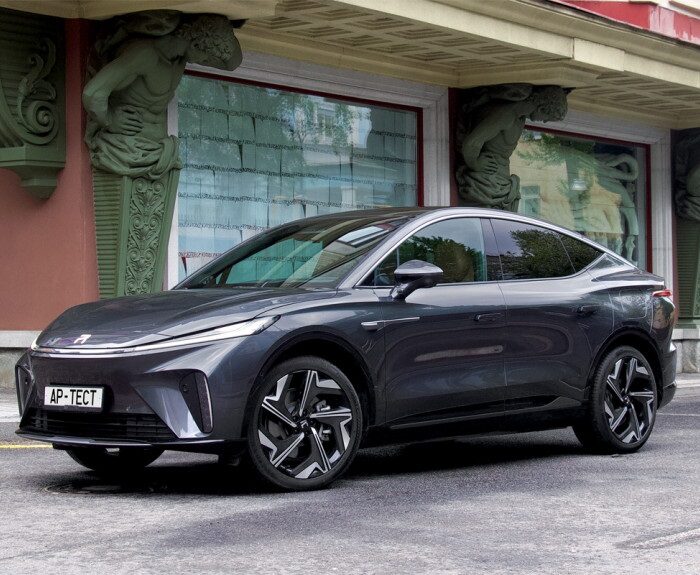Err. Err-rr! Somehow, the Englishman, Adam, just can’t engage the second gear on the Alfa Romeo Giulietta Spider. “You say double clutching?” he exclaims. “Err. Err-rr-rr-rr!” I tell him that won’t work. How can anyone drive with such a gearbox? Alright, Adam, it’s forgivable. Were you taught how to drive a GAZ-52 truck with a non-synchronized gearbox in well-off England? Let me do it.
The event, organized by the German private company Nostalgic Tours, is quite similar to a regular automotive journalist test drive. You fly to Italy, get paired up in cars, are given a roadbook, which is a legend of the upcoming route, and off you go through the roads of Tuscany. Then dinner, a night in a good hotel, and another almost full day of driving. The only difference is that the cars are not new; they are old: Alfa Romeo spiders from the 50s, 60s, and 70s. And the Alfa Romeo brand itself has no direct connection to “nostalgic tours” – a few German alfisti, lovers of old Alfas, decided to share their passion with the world and turned it into a small business. They bought about twenty retro cars of their favorite brand, hired a former Italian racing mechanic to maintain them, and offer “nostalgic tours” for about 2500 euros per person.
For me, this tour carries a completely different meaning: if a Soviet person can feel nostalgic, it’s probably only for the humpbacked Zaporozhets, the VAZ “kopeyka,” or that “gazon” whose gearbox I ground while receiving some colorful language lessons from the mentor at Auto Plant No. 1. Alfa Romeo Giulietta, Giulia, or Spider were nothing more than a dream, a dream that one could only read about in the DOSAAF magazine Behind the Wheel.
And now, here I am, along with Englishman Adam, able to try out all the cars from the Nostalgic Tours park. And if we follow the chronology, we should start with the earliest Alfa.
So, it was called Giulietta…

The early fifties, Italy emerging from the post-war depression, mass transport: bicycles, Isetta motor scooters made under license from BMW. The grandeur of pre-war Alfa Romeo was in the past when eight-cylinder beauties and victorious racing cars were built with funds from the fascist government. The war was behind them – the production of aircraft engines for Italian fighters and bombers, the complete destruction of the main Portello factory in Milan, attempts to manufacture kitchen stoves at the surviving southern branch in Pomigliano. But the engineers in love with speed didn’t leave Alfa Romeo – designer Orazio Satta, engine builder Giuseppe Busso, creator of the pre-war Alfa Romeo 158 “formula,” Giuseppe Colombo. Although the first post-war model turned out to be a failure – the Alfa Romeo 1900 sedan was too large and expensive for impoverished Italy. Thus, by all means, with loud presentations and an announcement of a nationwide lottery (the winners of which never received the promised 200 initial cars), Alfa Romeo managed to gather funds for a more compact mass model, which was put on the assembly line in 1954 under the name Giulietta.
Some say that the name, the first “personal” one for Alfa Romeo, was suggested by the wife of the famous Italian poet of that time, Leonardo Sinisgalli. Others mention a certain Russian nobleman who was an impresario in a Milan nightclub and joked when people from Alfa Romeo introduced themselves: “You have eight Romeos here and not a single Juliet?”
Either way, Giulietta emerged as a beauty. Even the sedan was nice, much more attractive than its Soviet contemporary, the Moskvich-402. And the coupe by Bertone and the spider by Farina…


What I feared most was the tightness and the infamous “Italian driving position” that wraps the steering column with your legs – the clutch and brake pedals plus the hanging accelerator. The compact seat is positioned practically at floor level, allowing you to sit in a racecar-like posture with your legs stretched out. To put it in perspective, if you were to compare it to a supercar of that era, like the Jaguar E-Type, which I recently “squeezed” into during the Monte-Carlo Historique rally, the Giulietta triumphs in terms of ergonomics with its elegant pedal feel. It’s as if the Giulietta gently taps you with a graceful foot in a stylish shoe. In the “E-Type,” you sit somewhat hunched over, whereas here, you recline halfway, reminiscent of lounging on a chaise longue. It’s the dolce vita, the sweet life under the boundless Apennine sky!
But proceed with caution: no seatbelts, no safety features to speak of, and the hub of the steering wheel is directed right at your chest. As you navigate through a chaotic curve, you might wonder if the next scooter approaching at breakneck speed will choose the left side.
However, fear not; such concerns won’t plague you with an Alfa. This car was born to bring nothing but happiness!
The slender pedals are nestled close to the transmission tunnel – floor-mounted brakes and clutch, complemented by a suspended accelerator. When you press down on the gas pedal, the 1300cc engine initially struggles, not due to emotions, but due to an abundance of air. It seems that the check valve in the accelerator pump is having trouble holding it all back.


Ah, where is my thirteen and the white VAZ “kopeyka” with the black license plate 57-71 MTB? Back then, in the early ’80s, the sound of the “Italian” engine caressed the ears amidst the bassy Moscow-made cars – and now, I recognize those “VAZ” silky tones. Classic Italy! After all, the architecture of this “four” was laid out even before the war by the legendary Vittorio Jano, the engine builder Lanzi, and Ferrari. Aluminum block with cast iron liners, five-bearing forged crankshaft, hemispherical combustion chamber, two “upper” camshafts driven by a double-row chain, centrally positioned spark plugs. In various variations, this engine lived on FIAT Group assembly lines until 1995!
When the carburetor finally draws fuel through all its intricate channels and there’s a smooth pull, it’s not enough: the engine doesn’t have the power for steep hills, and you have to gradually shift down to first gear. Nikita Gudkov praised the Giulietta coupe for its acceleration dynamics, but he was driving a well-maintained private car. The cars at Nostalgic Tours, consider them as rentals, and it’s unlikely that most riders know how to handle delicate retro technology properly.

Giulietta was famous not only for its design but also for its handling! The Moscow-made Moskvich-402 of that time had a lower-valve “cast iron” 35-horsepower engine, only three gears with a lever shift under the steering wheel, and a rear axle on leaf springs – and even the 1958 model Moskvich-407 engine, already with overhead valves, an aluminum head, and bored to 1360cc, developed only 45 horsepower. While the engine of the simplest Giulietta sedan had 53 hp, multiplied by four “short” gears, and in the coupe and spider, the same 1300cc engine was boosted to 81 horsepower! There was also the lighter and tuned Giulietta Veloce, “Fast”: 90 hp and minus 75 kg of curb weight…
The thin steering wheel made of black “bone-like” plastic initially feels light, but as soon as you turn it, your hands feel its weight: the car’s front immediately moves to the side, overcoming its insufficient maneuverability. But in a moment, Giulietta adjusts, the steering wheel “lightens”… It’s due to Lancia’s independent suspension “all around” that was there even before the war, and Horacio Satta and colleagues opted for a cheaper variant: an undivided rear axle. Although it’s suspended on springs and additionally connected to the body with a third central A-shaped lever. But even the red Koni Classic shock absorbers combined with 15-inch Uniroyal radial tires don’t compensate for the kinematic imperfections. Therefore, fast corners in the Giulietta have to be navigated with a “searching steering,” balancing between insufficient and excessive maneuverability.

And what about the gearbox? Going up – only with double clutching, and going down – with an intermediate blip on neutral to rev the primary shaft. Actually, the transmissions in the Giulietta roadsters were fully synchronized, which was a luxury at that time. Moreover, Italians bought a license for synchronizers from Porsche. But this particular car seems to be quite worn – the body shines with fresh paint, chrome glows in the Italian sun, but the synchronizers are “dead.” Err-rr-rr-rr, err-rr-rr! Englishman Adam only filled the Tuscan hills with a dreadful grinding of gears and lost momentum, unable to engage second gear after third or fourth.
No matter what anyone says, I remain with Suvorov’s principle: “Hard in training, easy in battle!” I learned to drive on “logs” in my youth – I drove anything that had pistons, regardless of the presence of brakes or the play in the steering wheel – if you can drive that, you can drive anything!

A lunch break – a chance to switch to the Giulia. It was a change of generations, but while the Giulia sedans significantly differed from the Giuliettas, the coupes and roadsters underwent minor modernization. Moreover, it was a phased process (remember the transition from the VAZ “ten” to the Prioras?). The transformation of the Giulietta into the Giulia began in 1959 with a longer wheelbase and was completed in 1965 when a higher 1600cc engine required adding nostrils to the air intake. A questionable adornment, but 90 hp – now that’s more fun! And the gearbox in this car was in perfect order – the gears engaged without problems, easily and precisely. But the brakes! There were simply no brakes in the front; only the rear ones worked. Pressed slightly harder – and a slide! It was this car that later got into an accident involving a Dutch businessman-publisher’s wife: she braked too hard before a turn – and the beautiful Alfa instantly spun and hit a barrier with its trunk. Luckily, not too seriously.
But an evacuation truck follows the convoy for such cases, with a replacement car – and I also had to use its services. I’m driving an Alfa Romeo 2600 convertible – and suddenly…


A row of dual overhead camshafts powers the six-cylinder engine: 145 horsepower, equipped with three Solex carburetors, but… the spark seems to have vanished.
This car is clear proof that “more expensive” doesn’t necessarily mean “better.” This model didn’t have its own name – the 2600 index reflected the displacement of the inline “six,” which finally returned under the hoods of Alfa’s road cars for the first time since pre-war times. The Alfa 2600 sedan in 1961 replaced the previous flagship Alfa Romeo 2000, and the coupes and roadsters based on it were designed by Giugiaro and Carrozzeria Touring, respectively. They tried to maintain the design in the Giulietta style, and…
Well, of course, it’s beautiful. But there’s no longer that organic feel. Six cylinders sound softer and more refined than the four in the Giulietta, and the suspension is more comfortable – while the Giulietta constantly jolts on a bad road with its light body (remaining, however, solid and monolithic), the Alfa 2600 rides noticeably smoother. But the car is heavier and accelerates slower. And the steering is heavy in corners – hard to turn! Pronounced understeer.

So pronounced that there’s simply no desire to go fast at all. Just leisurely cruising, looking around at the Tuscan beauty. At these sparsely wooded hills, the rows of sentinel cypresses lining the straight paths covered in crisp white gravel, at the endless vineyards…
And, of course, a convertible – it’s an entirely different level of connection with the surrounding world. Especially an old convertible. When the wind noise and the birds’ chirping blend with the guttural rumble of the carbureted engine, and the bitter smell of “unclean” exhaust mixes with the aromas of the blessed Tuscan soil…
And the wind in your face, indeed.
But suddenly – “tr-r-r-r-r”: the engine lost power and stalled. Like someone turned it off. Rolled to the side using the starter, lifted the hood… Ah, I’ve lost my skills. Before, without hesitation, I would’ve checked the fuel level in the float chamber or pulled out the high-voltage wire – to see the spark. But it’s been a while since I held any wrenches, and Alfa isn’t a Zaporozhets. So, 15 minutes after the call, co-owner of Nostalgic Tours, Gert Pichler, arrived with his colleague, the lovely Russian girl Alena Bychikhina, and they loaded the “dead” Alfa 2600 onto the evacuation truck, and in return, Adam and I got an Alfa Romeo Spider.


It replaced the Giulia in 1966 – its streamlined low body design reminiscent of the Jaguar E-Type. But the technology was much simpler: still a rigid rear axle and steering of the “worm and roller nut” type. The initial name “Duetto,” found through a nationwide competition, didn’t really catch on – from the mid-70s, it was simply known as the Spider. And I’m driving a second-generation car from the early 70s, already with the truncated rear and a 133-hp 2-liter engine.
The interior is made of black plastic, and the instrument gauges face downwards, just like in modern Alfas. The power delivery is cheerful and smooth, albeit with typical carburetor hesitations. The brakes are modern with a vacuum booster: the pedal is light, the car doesn’t lunge anywhere… But the handling is still at a 90s level: reactions in the near-zero zone are lazy, and then the steering wheel suddenly loads up with effort and responsiveness increases. Plus, there are “rubber” reactions – the tires are full-profile, straight from the 60s.
And you feel the road more acutely than in modern cars. Even on smooth asphalt, you constantly feel slight vibrations, and as soon as you turn onto a dirt road, the cabin starts to rattle, and there’s a noticeable play in the steering wheel.
But the Spider of those times was far from a supercar – just like the Giulietta-Giulia. Nowadays, this niche is filled by cars like the Audi TT or BMW Z4 – expensive cars, but still accessible not only to millionaires. Actresses and artists, lawyers and dentists bought them… And enjoyed life.
That’s what the organizers of “nostalgic tours” sell – the opportunity to be like the successful “middle class” of half a century ago. And for the sake of authenticity, they organize dinners in a castle-museum, where the owners personally welcome the guests and display family paintings, furniture, tableware, clothing, or porcelain dolls collected over centuries. Or in a small family restaurant, where a huge plate of homemade pasta generously sprinkled with the most delicate truffles found in the local woods costs just ten euros. Four hundred rubles in our currency, and it’s so delicious that you’re willing to swallow your own tongue.


Recognize those circular additional gauges and round dashboard defrosters? Those are from FIAT.
In short – Italy.
And here…
At the turn of the 50s and 60s, my father, if he could dream of a convertible, could only dream of the GAZ-69 “goat.” But he was driving a GAZ-51 truck back then – when in 1956, they, students of the Ural Mining Institute, were sent to harvest the famous “golden billion,” an unexpectedly abundant wheat harvest from the recently plowed Kazakh steppes. The grain was rotting, it was dumped into nearby swamps, there were not enough people, machines, elevators, or train cars. And the students brought to Kazakhstan had nothing to eat, so they sent my father home to Sverdlovsk for a rifle. He and a friend rode on top of train cars for free, enjoying the wind in their faces, and brought back to Mamlyutka station a 16-gauge “tulka,” and tried to shoot passing ducks to get some meat…
Alas, we didn’t have roadsters or spiders, we didn’t have an easy life. Our nostalgia for Alfas is imaginary. Like false pregnancy or phantom pains. We had Belka and Strelka, we had Sputnik and Gagarin, we had Tu-22 and BTR-60. And we had the Pobeda and the Volga, the “emka” and the “one and a half”…
I drove them too. Not in Italy, of course – in Nizhny Novgorod, at the Gorkyclassic GAZ anniversary festival. I’ll tell you more next time.

Photo: Nostalgic Tours Company | Leonid Golovanov
This a translation. You can read the original article here: Леонид Голованов поездил на старых Alfa Romeo из коллекции Nostalgic Tours

Published August 30, 2023 • 14m to read





